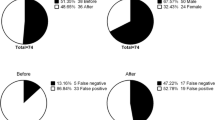Abstract
Endoscopic brush cytology (EBC) was performed in antral and duodenal brushings of children subjected to upper GI endoscopy for the detection of H. pylori (Hp) and trophozoites of Giardia lamblia (Glt) in addition to routine endoscopic grasp biopsy (EGB). It was hospital based prospective study. EBC was performed in children subjected to upper GI endoscopy with a sheathed cytology brush. Mucosal brushings were collected from antrum, body of the stomach and second or third part of duodenum by gently rubbing the surface of the brush with the mucosal wall in all the directions, brush withdrawn and brushings performed on a glass slide. The smears were placed in 95% ethyl alcohol and later examined for Glt and Hp using Giemsa and Hematoxylin & Eosin stain. EGB was taken from antrum, body of the stomach and duodenum from sites other than those used for brushings. One hundred and seventy children between 1–13 years (median age = 5 years) were subjected to upper GI endoscopy for malabsorption (n= 94), recurrent abdominal pain (n= 49), failure to thrive (n= 16) and recurrent vomiting / regurgitation (n= 11) and EBC was performed in addition to routine EGB. Thirty five children (20.4%) were colonized by Hp, 14 (8.2%) were detected to have Glt and in 6 cases (3.5 %) both Hp as well as Glt were detected. Out of 41 cases colonized by Hp, 24 cases (58.5 %) were detected by EGB and 27 cases (65.8%) were detected by EBC. Out of 20 children in whom Glt were detected from their duodenum, the detection was by EBG in 12 cases (60%) and by EBC in as many as 19 cases (95%).Comparison of EGB and EBC suggested that detection rates with EBC were higher than EGB. Detection by EBC was significantly higher for Glt than Hp. There were no complications attributed to EBC and procedure time for endoscopy was not significantly prolonged. On the contrary, detection of Hp and particularly Glt in higher proportion of cases with the help of EBC was helpful in their appropriate management. Our results suggest that EBC is a safe and useful tool to enhance the value of diagnostic endoscopic procedure when used in combination with routine EGB.
Similar content being viewed by others
References
Brown KE, Peura DA. Diagnosis of Helicobacter pylori infection.Gastroenterol Clin North Am 1993; 22: 105–109.
Burke JA. The clinical and laboratory diagnosis of giardiasis.Crit Rev Clin Lab Sci 1977; 7: 373–391.
Dalla LM. Brush cytology: Helicobacter pylori and unexpected giardia.Gastrointest Endos 1995; 41 : 617–618.
Sherman PM. Peptic ulcer disease in children. Diagnosis, treatment and the implication of Helicobacter pylori.Gastroenterol Clin North Am 1994; 23: 707–725.
Danciger H, Lopez M. Number of giardia in the feces of infected children.Am J Trap Med Hyg 1975; 24: 237–242.
MaCarthur C, Sounders N, Feldman W. Helicobacter pylori, gastroduodenal disease and recurrent abdominal pain in children.JAMA 1995; 273: 729–735.
Bansal D, Patwari AK, Logani KB, Malhotra VL, Anand VK. Study of diagnostic modalities and pathology of Helicobacter pylori infection in children.Indian J Pathol Microbiol 1999; 42: 311–315.
Dalla LM, Pazzi P, Carli Get al. Brush cytology: a reliable method to detect Helicobacter pylori.J Clin Gastroenterol 1996; 22: 317–321.
De Francesco F, Nicotina PA, Picciotto Met al. Heliocbacter pylori in gastroduodenal disease: rapid identification by endoscopic brush cytology.Diagn Cytopathol 1993; 9 : 430–433.
Shepherd RW. Giardiasis Clinical Features and Treatment.International Seminars on Paediatric Gastroenterology and Nutrition 1997; 6 (1): 9–13.
Marshall JB, Kelley DII, Vogele KA. Giardiasis, diagnosis by endoscopic brush cytology of the duodenum.Am J Gastroenterol Nutr 1984; 79: 517–519.
Bendig DW. Diagnosis of Giardiasis in infants and children by Endoscopic brush cytology.J Pediatr Gastroenterol Nutr 1989; 8: 204–206.
Author information
Authors and Affiliations
Rights and permissions
About this article
Cite this article
Patwari, A.K., Anand, V.K., Malhotra, V. et al. Brush cytology: An adjunct to diagnostic upper GI endoscopy. Indian J Pediatr 68, 515–518 (2001). https://doi.org/10.1007/BF02723244
Issue Date:
DOI: https://doi.org/10.1007/BF02723244




